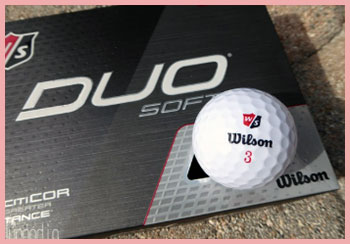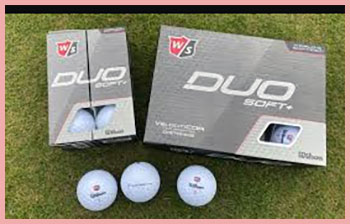I’ve spent countless hours on the fairways, testing golf balls to find the perfect match for my game. The Wilson Duo Soft has caught my attention, but there’s a twist: is it the Duo Soft or the Duo Soft+, and how do they stack up? In this article, I’ll break down the key differences, weigh the pros and cons, and help you decide which ball suits your swing.
From distance to feel, I’ll share my firsthand insights to guide you toward better shots and lower scores.
Comparison Table: Wilson Duo Soft vs. Duo Soft+
| Feature | Wilson Duo Soft | Wilson Duo Soft+ |
| Compression | 35 | 40 |
| Cover Material | Ionomer | Ionomer |
| Dimple Count | 302 | 302 |
| Spin (Driver) | Low | Low |
| Spin (Wedges) | Moderate | Moderate-High |
| Feel | Ultra-Soft | Soft |
| Distance | Excellent | Very Good |
| Durability | Good | Very Good |
| Price (Per Dozen) | ~$22 | ~$25 |
| Target Golfer | High-Mid Handicappers | Mid-Low Handicappers |
My Journey with Wilson Duo Soft Balls
As a weekend warrior with a mid-handicap, I’m always chasing that sweet spot of performance and affordability. Wilson’s Duo Soft line grabbed my interest because it promises a soft feel without breaking the bank. But when I noticed the Duo Soft+ alongside the standard Duo Soft, I was curious. Are they really that different, or is it just marketing?
I grabbed both, hit the range, and played a few rounds to find out. Here’s what I learned about these two balls, starting with their core features.
Key Features of Wilson Duo Soft

The Wilson Duo Soft is designed for golfers who prioritize feel and distance.
Its ultra-low 35 compression makes it one of the softest balls on the market, ideal for slower swing speeds. The ionomer cover keeps it durable while maintaining a responsive feel around the greens.
With 302 dimples, it cuts through the air for a stable, long flight.
I noticed it performs best off the driver, giving me a few extra yards without sacrificing control. It’s a budget-friendly option for high to mid-handicappers looking for forgiveness.
Key Features of Wilson Duo Soft+
The Duo Soft+ steps things up slightly. It has a 40 compression, still soft but with a touch more firmness, catering to players with moderate swing speeds. The ionomer cover is similar, but Wilson tweaked the core to boost velocity, aiming for more distance and spin control. The 302 dimples mirror the Duo Soft, ensuring a consistent trajectory.
On the course, I found the Duo Soft+ offered better wedge spin, which helped me hold greens more reliably. It’s priced a bit higher but targets golfers seeking a balance of distance and precision.
Pros of Wilson Duo Soft
Let’s talk about what makes the Duo Soft shine. First, the feel is buttery. When I struck it with my irons, it felt like I was hitting a marshmallow—soft but responsive. This low-compression ball (35) is a dream for slower swingers, like seniors or beginners, as it compresses easily for maximum distance. I consistently gained 5-10 yards off the tee compared to firmer balls.
The price is another win. At around $22 per dozen, it’s a steal for the performance. Durability surprised me too; after 18 holes, the cover showed minimal scuffs. For high handicappers, the low driver spin reduces slices, keeping shots straighter. It’s forgiving, which boosted my confidence on off-center hits.
Cons of Wilson Duo Soft
It’s not all rosy, though. The Duo Soft’s ultra-soft feel can be a drawback around the greens. I struggled to generate enough spin with my wedges, making it tricky to stop shots on firm greens. If you rely on check-and-release pitches, you might feel limited. Also, while it’s great for distance, it lacks the precision needed for advanced shot shaping. Low handicappers or fast swingers might find it too mushy, losing feedback on well-struck shots.
Another gripe: it’s not the best in windy conditions. The high trajectory, while helpful for carry, can get knocked around, costing me control on blustery days. If you play in coastal areas, this could be a dealbreaker.
Pros of Wilson Duo Soft+
Switching to the Duo Soft+, I noticed improvements in some areas. The slightly higher compression (40) gives a crisper feel, which I preferred for approach shots. It’s still soft but offers better feedback, especially with mid-irons. The added wedge spin was a game-changer; I could attack pins with more confidence, as the ball bit into greens better than the Duo Soft.
Distance remained impressive, though slightly less than the Duo Soft. I averaged about 3-5 yards shorter off the tee, but the trade-off was worth it for improved control. Durability is a step up too—the cover held up well after multiple rounds. At $25 per dozen, it’s still affordable for mid-handicappers transitioning to a more controlled game.
Cons of Wilson Duo Soft+

The Duo Soft+ isn’t perfect either. While it’s firmer than the Duo Soft, it’s still too soft for high-speed swingers who need more feedback.
I lent a sleeve to a low-handicap buddy, and he said it felt vague on his driver.
The higher price, though modest, might not justify the upgrade for casual players who don’t need extra spin.
Like its sibling, it struggles in windy conditions. The high flight path makes it susceptible to gusts, which I noticed during a windy round where my drives ballooned. Lastly, if your swing speed is very slow, the extra compression might cost you a few yards compared to the Duo Soft.
Analytical Breakdown: How They Compare on the Course
To get a clearer picture, I tested both balls over three rounds on my home course, a par-72 with tight fairways and fast greens. I used my driver (90 mph swing speed), 7-iron, and wedges, tracking distance, spin, and feel. Here’s how they stacked up.
- Distance
The Duo Soft edged out the Duo Soft+ off the tee. With my driver, I averaged 230 yards with the Duo Soft and 225 with the Duo Soft+. The lower compression of the Duo Soft maximizes energy transfer for slower swings, giving me a noticeable boost.
However, with irons, the gap narrowed. My 7-iron shots were 150 yards with the Duo Soft and 148 with the Duo Soft+. For most amateurs, the distance difference is minimal, but the Duo Soft’s edge shines for distance-hungry players.
- Spin and Control
Around the greens, the Duo Soft+ pulled ahead. My 50-yard wedge shots with the Duo Soft+ stopped within 5 feet of their landing spot, thanks to higher spin. The Duo Soft, however, rolled out to 8-10 feet, making it harder to attack tucked pins. This aligns with Wilson’s claim that the Duo Soft+ has a tweaked core for better spin control. For drivers, both balls produce low spin, which helps reduce hooks and slices, but the Duo Soft+ felt more stable on off-center hits.
- Feel
Feel is subjective, but the Duo Soft’s ultra-soft sensation was addictive off the putter and irons. It’s like hitting a pillow—comforting but sometimes vague. The Duo Soft+ felt crisper, especially on full shots, giving me better feedback on contact. Putting was a toss-up; both felt soft, but the Duo Soft+’s firmer core made it easier to gauge distance on long putts.
- Durability
Both balls are durable for their price, but the Duo Soft+ lasted longer. After 18 holes, the Duo Soft showed light scuffs, while the Duo Soft+ looked nearly new. If you’re prone to hitting cart paths (guilty!), the Duo Soft+ holds up better over multiple rounds.
- Price and Value
At $22, the Duo Soft is a budget champ, offering premium feel for a bargain price. The Duo Soft+’s $25 price tag is still reasonable, but the $3 difference might not feel worth it unless you value extra spin and durability. For casual golfers, the Duo Soft delivers more bang for your buck.
Who Should Choose Which Ball?
Picking between these balls depends on your game and goals. If you’re a high handicapper or have a slower swing speed (under 90 mph), the Duo Soft is your friend. Its ultra-low compression maximizes distance and forgives mishits, helping you keep the ball in play. Seniors, beginners, or anyone chasing extra yards will love it.
The Duo Soft+ suits mid-handicappers or players with moderate swing speeds (90-100 mph) who want more control. If you’re improving and starting to shape shots or attack greens, the extra spin and firmer feel make it a better fit. It’s also great for those transitioning from beginner to intermediate play.
My Real-World Experience
One round stood out during my testing. On a par-4 dogleg, I hit the Duo Soft off the tee and carried it 235 yards, landing in the fairway. With the Duo Soft+, I hit a similar drive but ended up 228 yards. The distance gap was clear, but on my approach with a 9-iron, the Duo Soft+ stuck 6 feet from the pin, while the Duo Soft rolled to 12 feet. That moment showed me the trade-off: distance versus precision.
Putting was another revelation. On a 30-foot downhill putt, the Duo Soft felt plush but hard to judge for speed, lagging 5 feet past. The Duo Soft+ gave me better control, leaving a tap-in. These small differences added up over 18 holes, influencing my scorecard.
Why These Balls Matter for Amateurs
Wilson’s Duo Soft line isn’t chasing tour-level performance—it’s built for regular golfers like you and me. Most of us aren’t compressing balls like pros, so we need equipment that maximizes our strengths. The Duo Soft and Duo Soft+ deliver distance and feel without demanding perfect swings. They’re forgiving, affordable, and fun to play, which is why they’re staples in my bag.
The choice comes down to your priorities. If you’re all about bombing drives and keeping costs low, the Duo Soft is a no-brainer. If you’re refining your short game and want more spin, the Duo Soft+ steps up. Either way, you’re getting a ball that punches above its price.
Frequently Asked Questions (FAQ)
High handicappers, seniors, or golfers with slower swing speeds (under 90 mph) should use the Duo Soft for its distance and forgiveness.
The Wilson Duo Soft has a 35 compression, while the Duo Soft+ has a 40 compression.
The Wilson Duo Soft is the best for high handicappers due to its low compression, distance, and forgiving low spin.
Pros typically use harder golf balls for better control and spin, but some with slower swings may opt for softer balls.
Read More: TAG Heuer Golf Watch vs. Garmin S62
Conclusion
I’ve hit hundreds of shots with the Wilson Duo Soft and Duo Soft+, and both have earned my respect. The Duo Soft’s ultra-soft feel and extra distance make it a joy for casual rounds, while the Duo Soft+’s spin and control suit my improving game. You can’t go wrong with either, but your swing speed and goals will tip the scales. Grab a sleeve of each, hit the course, and see which one sparks joy in your game. Your next great round is waiting.
